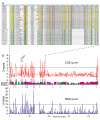Sub-grouping and sub-functionalization of the RIFIN multi-copy protein family
- PMID: 18197962
- PMCID: PMC2257938
- DOI: 10.1186/1471-2164-9-19
Sub-grouping and sub-functionalization of the RIFIN multi-copy protein family
Abstract
Background: Parasitic protozoans possess many multicopy gene families which have central roles in parasite survival and virulence. The number and variability of members of these gene families often make it difficult to predict possible functions of the encoded proteins. The families of extra-cellular proteins that are exposed to a host immune response have been driven via immune selection to become antigenically variant, and thereby avoid immune recognition while maintaining protein function to establish a chronic infection.
Results: We have combined phylogenetic and function shift analyses to study the evolution of the RIFIN proteins, which are antigenically variant and are encoded by the largest multicopy gene family in Plasmodium falciparum. We show that this family can be subdivided into two major groups that we named A- and B-RIFIN proteins. This suggested sub-grouping is supported by a recently published study that showed that, despite the presence of the Plasmodium export (PEXEL) motif in all RIFIN variants, proteins from each group have different cellular localizations during the intraerythrocytic life cycle of the parasite. In the present study we show that function shift analysis, a novel technique to predict functional divergence between sub-groups of a protein family, indicates that RIFINs have undergone neo- or sub-functionalization.
Conclusion: These results question the general trend of clustering large antigenically variant protein groups into homogenous families. Assigning functions to protein families requires their subdivision into meaningful groups such as we have shown for the RIFIN protein family. Using phylogenetic and function shift analysis methods, we identify new directions for the investigation of this broad and complex group of proteins.
Figures




References
-
- Gardner MJ, Hall N, Fung E, White O, Berriman M, Hyman RW, Carlton JM, Pain A, Nelson KE, Bowman S, Paulsen IT, James K, Eisen JA, Rutherford K, Salzberg SL, Craig A, Kyes S, Chan MS, Nene V, Shallom SJ, Suh B, Peterson J, Angiuoli S, Pertea M, Allen J, Selengut J, Haft D, Mather MW, Vaidya AB, Martin DM, Fairlamb AH, Fraunholz MJ, Roos DS, Ralph SA, McFadden GI, Cummings LM, Subramanian GM, Mungall C, Venter JC, Carucci DJ, Hoffman SL, Newbold C, Davis RW, Fraser CM, Barrell B. Genome sequence of the human malaria parasite Plasmodium falciparum. Nature. 2002;419:498–511. doi: 10.1038/nature01097. - DOI - PMC - PubMed
-
- del Portillo HA, Fernandez-Becerra C, Bowman S, Oliver K, Preuss M, Sanchez CP, Schneider NK, Villalobos JM, Rajandream MA, Harris D, Pereira da Silva LH, Barrell B, Lanzer M. A superfamily of variant genes encoded in the subtelomeric region of Plasmodium vivax. Nature. 2001;410:839–842. doi: 10.1038/35071118. - DOI - PubMed
-
- Fischer K, Chavchich M, Huestis R, Wilson DW, Kemp DJ, Saul A. Ten families of variant genes encoded in subtelomeric regions of multiple chromosomes of Plasmodium chabaudi, a malaria species that undergoes antigenic variation in the laboratory mouse. Mol Microbiol. 2003;48:1209–1223. doi: 10.1046/j.1365-2958.2003.03491.x. - DOI - PubMed
Publication types
MeSH terms
Substances
LinkOut - more resources
Full Text Sources
Other Literature Sources

